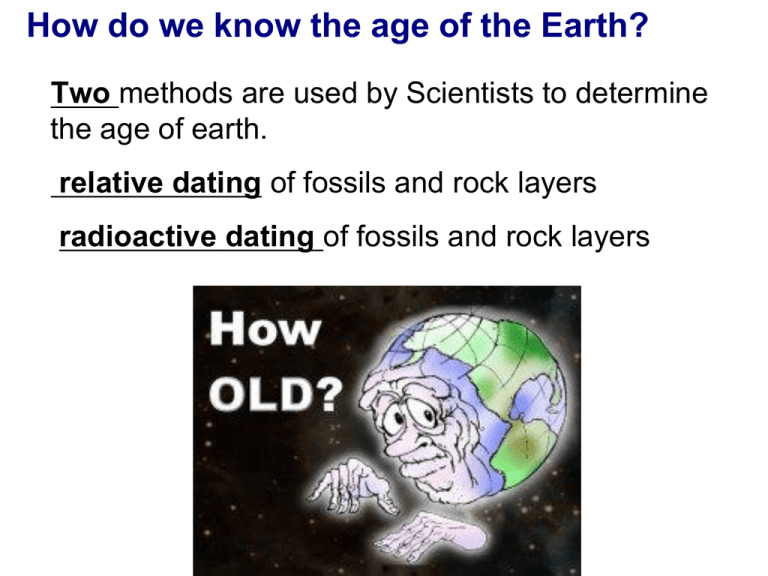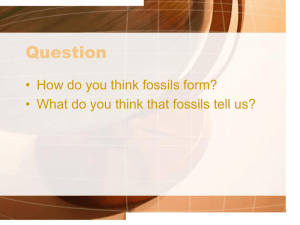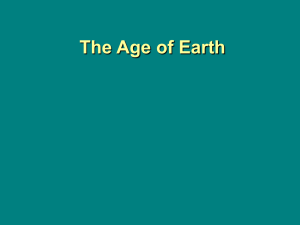
How do we know the age of the Earth?
Two methods are used by Scientists to determine
the age of earth.
relative dating of fossils and rock layers
radioactive dating of fossils and rock layers
Fossils and Ancient Life
Fossils and Ancient Life
All information about past life is called the fossil record.
The fossil record includes information about the
structure of organisms,
what they ate,
what ate them,
in what environment they lived,
and the order in which they lived.
Interpreting Fossil Evidence
Relative Dating
In relative dating, the age of a fossil is determined
by comparing its placement with that of fossils in
other layers of rock.
Rock layers form in order by age— the oldest on
the bottom, with more recent layers on top.
Interpreting Fossil Evidence
Relative Dating
Interpreting Fossil Evidence
Index fossils are used to compare the relative
ages of fossils.
An index fossil is a species that is recognizable
and that existed for a short period but had a wide
geographic range.
Interpreting Fossil Evidence
Relative dating
allows scientists to
estimate a fossil's
age compared with
that of other
fossils.
IB Assessment Statement:
D.3.7 Discuss the incompleteness of
the fossil record and the resulting
uncertainties about human evolution
Copyright Pearson Prentice Hall
.
Why is the human fossil record incomplete?
• Fossils are rare, because fossilization requires
certain conditions
• Some body parts do not fossilize/ soft parts do not
fossilize
• Dead organisms are destroyed by predators,
climate, water damage before they fossilize
• Not all the fossils have been found
• Fossils degenerate over time. Thus, the oldest
fossils might be reduced to dust
Copyright Pearson Prentice Hall
Discuss the incompleteness of
the fossil record and the resulting uncertainties about human evolution
(6 points)
• Only part of organisms found :
• Some parts of living organisms do not fossilize
• Fossilization is rare and fossilization requires certain conditions; dating
only approximate;
• Fossils may not be representative of the species;
• Rarity of fossil formation lead to missing links in the fossil record;
• Naming/ give an example of one or more hominid species found in the
fossil record (accept Genus only or anglicized name, but not "Lucy");
• Many aspects of human evolution (eg language) are not represented in
fossil record;
Copyright Pearson Prentice Hall
A sample comes from:
IB Assessment Statements:
D.3.1 Outline the method for dating rocks
and fossils using radioisotopes, with
reference to 14C and 40K.
D.3.2 Define half-life.
D.3.3 Deduce the approximate age of
materials based on a simple decay curve
for a radioisotope.
Copyright Pearson Prentice Hall
Radioactive Dating
Radioactive dating – using the radioactive
decay of isotopes to date rocks and fossils.
Isotopes:
• An isotope is a version of an element with a
different number of neutrons from the
usual version of the same element.
• EXAMPLE: Carbon has three isotopes
Isotope
Mass
Number
Protons
Electron
Neutrons
14 C
Carbon-14
14
6
6
8
13 C
Carbon-13
13
6
6
7
12 C
Carbon 12
12
6
6
6
Copyright Pearson Prentice Hall
Radioisotopes:
• Certain isotopes are unstable an in order
to reach a stable state they release some of
their subatomic particles.
• Carbon 14 is unstable. Right now carbon
14 in your body is shooting off radioactive
subatomic particles and it is becoming more
stable a more stable isotope(nitrogen -14)
Copyright Pearson Prentice Hall
When we die we do not take in anymore carbon
atoms.
Carbon-12 is not radioactive and does not decay.
Carbon-14 decays into nitrogen-14 (Nitrogen-14
is called the daughter isotope of carbon-14) at a
known rate.
Thus, by comparing the amounts of carbon-14
and carbon-12 in a fossil, researchers can
determine when the organism lived.
Determining known rates of decay of isotopes:
• Unstable isotopes will decay into its more
stable form at a stable rate called Half
lives.
A half-life is the length of time required for half
of the radioactive atoms in a sample to decay to
it more stable form.
The more stable form that the radioactive atom
decays into is called the daughter isotope
Copyright Pearson Prentice Hall
Copyright Pearson Prentice Hall
Table 1: The below table shows radio active parent atoms
and their stable daughter isotopes. It also show how
long it takes for half the parent radioactive atom to decay
into the daughter isotope, called the half life.
Radioactive
Parent
Stable
Daughter
Potassium
40
Argon 40
Uranium 238 Lead 206
Carbon 14
Nitrogen 14
Half life
1.3 billion yrs
4.47 billion
years
5730 years
Interpreting Fossil Evidence
Copyright Pearson Prentice Hall
Copyright Pearson Prentice Hall
Geologic Time Scale
IBO Wants you to know the difference
between Carbon-14 & Potassium-40
Carbon-14 (14C)
Carbon-14 (14C) decays to Nitrogen-14 (14N)
Scientist compare the ratio of carbon -12 to
carbon-14 (14C: 12C) to determine the age of
fossils.
This techniques is good for dates for fossils of
the last 60,000 years
Copyright Pearson Prentice Hall
Potassium-40 (40K)
Potassium-40 (40K) decays to Argon-40 (40Ar)
Scientist compare the ratio of Potassium-40
Argon-40 (40K : 40Ar) to determine the age of
fossils.
This techniques is good for dates for fossils of the
gives good results for the 580 million years
But it is too slow to give reliable results for the
recent half million years
Potassium-40 (40K) decays to Argon-40 (40Ar)
Copyright Pearson Prentice Hall
Copyright Pearson Prentice Hall
Radiocarbon dating tutorial:
https://www.youtube.com/watch?v=ErgdpG_N9vQ
http://phet.colorado.edu/en/simulation/radioactive-datinggame
http://science.jburroughs.org/mbahe/BioA/starranimation
s/chapter16/videos_animations/carbon_14_dating_v2.h
tml
Copyright Pearson Prentice Hall
END OF SECTION










